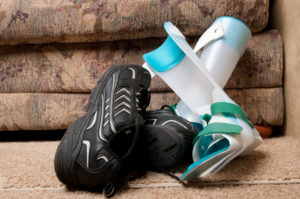Custom Ankle Foot Orthosis (AFO)
 Custom Orthotics
Custom Orthotics
Custom orthotics are semi-rigid devices designed to support and comfort your feet. These orthotic devices are crafted with plaster casts custom to the contours of your feet and are designed distinctly for the way you move. Unlike shoe inserts purchased over the counter, prescribed orthotic devices are molded to an individual’s foot and are made to last many years when properly cared for. Most insurances often help pay for the cost of custom-molded orthotics. Although, orthotics typically cost more than shoe inserts purchased in a retail store, the additional cost is foreseen in the following foot ailments.
What foot ailments are orthotics best for?
Podiatrists use orthotics to treat foot problems which include but are not limited to plantar fasciitis, tendinitis, bunions, hammertoes, diabetes, abnormal pronation, neuroma, arthritis, flatfeet, and heel pain.
Shoe Inserts –
Shoe inserts are non-prescribed affordable foot supports designed to be worn inside of a shoe. Unless the device is prescribed by a doctor and crafted to your specific foot, it’s a shoe insert. Our office provides cost-effective over-the-counter inserts which can be very helpful for a variety of foot ailments, including flat arches. Although, they can cushion your feet, provide comfort, and support your arches, it is important to note that shoe inserts cannot correct biomechanical foot problems.
Source: APMA, https://www.apma.org/orthotics
Custom Ankle Foot Orthosis (AFO):
An ankle-foot orthosis is an orthosis or brace that surrounds the ankle and at least part of the foot. AFOs are externally applied and intend to control position and motion of the ankle, compensate for weakness, or correct deformities. AFOs are commonly used in treatment of disorders affecting muscle function and peripheral neuropathy. The following are AFOs casted in our office.
Balance Brace –
Definition – Accidental falls are one of the most common causes of injury among older adults. A balance brace is an ankle-foot orthosis (AFO) designed to help reduce the risk of falls. As a balance brace is prescription-only, it is specially made for a patient. A balance brace is lightweight, easy-to-use, and helps prevents falls in the future. Balance braces are generally a covered benefit under most insurances.
Treatment – Patients who have had a stroke, drop foot, unstable gait, impaired balance, and diabetic peripheral neuropathy, among other diagnoses are candidates for a balance brace.
Crow Boot –
Definition – A Charcot Restraint Orthotic Walker (CROW), is a rigid boot designed to accommodate and support a foot with Charcot neuropathy. Patients with Charcot can begin using the CROW boot once swelling has decreased. Patients with mild to moderate Charcot deformities will benefit the most using a CROW boot.
Treatment – The CROW boot is custom-made for each patient’s foot. The outer shell consists of two plastic or fiberglass pieces that are strapped together with Velcro. The boot is sturdy and can be walked on and prevents other bones from breaking. The boot has a custom, removable foam insole that is adjusted to distribute weight equally and support the ankle joint.
Richie Brace –
Definition – The Richie Brace is a custom ankle brace designed to treat chronic conditions of the foot and ankle. It is fabricated from a custom cast taken of a patient’s foot and lower leg. The brace has a contoured balance orthotic footplate articulated to adjustable semi-rigid lower leg uprights. The Richie Brace is ideal to stabilize the midtarsal and subtalar joints. As the Richie Brace has lightweight construction it allows a better shoe fit, freedom of movement, and reduction of pain from injury. All Richie Braces must be fitted and dispensed by a health care provider.
Treatment – Chronic conditions that the Richie Brace treats include but are not limited to Drop foot, ankle sprains, and Posterior Tibial Tendon Dysfunction. Please refer to the source below to learn more about the Richie Brace.
Source: Richie Brace, www.richiebrace.com
